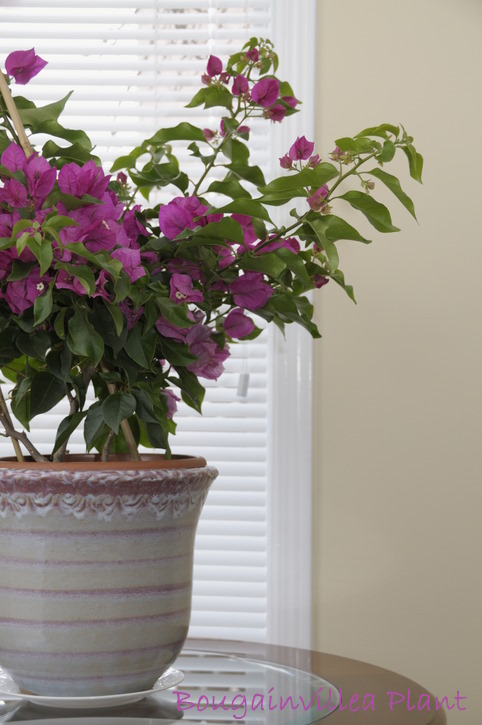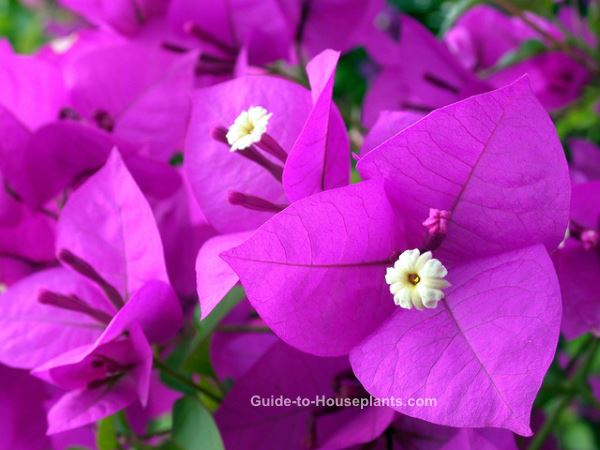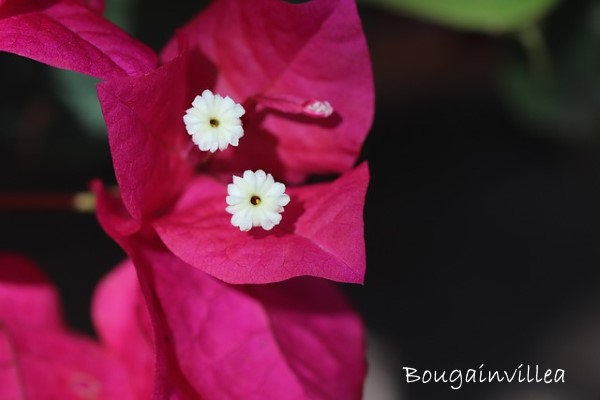Bougainvillea Plant Care
Botanical Name: Bougainvillea glabra
You'll find bougainvillea plant climbing arbors, scrambling along stone walls, and spilling over terra cotta pots in Mexico, Greece and Southern California...any place warm and sunny will make these flowering shrubs flourish.
If you don't happen to live in a hot climate, a sunny window, greenhouse or sunroom will do.
Varieties of Bougainvilleas
Of the hundreds of bougainvillea types, Bougainvillea glabra is the easiest to grow indoors and has long been a popular house plant.
In fact, it thrives in a pot or hanging basket as long as you can meet its need for sunlight. You'll give it even more blooming power if you can move your container outdoors for the summer. That's right -- you'll get the most flowers if you let these tropical beauties bask on your sunlit porch or patio.
Big clusters of brightly colored bracts in pink, red, orange or purple cover the plant summer through fall. The papery bracts surround 3 small, creamy white flowers. Bracts are long-lasting, but the actual white flowers nestled in the bracts are short-lived.
You can buy bougainvillea plants early in the growing season. Even young bougies are eager to bloom, so you won't wait long for those captivating bracts to cover your plant.
Varieties of Bougainvillea
You have lots of beautiful bougainvillea varieties to choose from, including dwarf, thornless, and some exciting new cultivars with variegated foliage.
- Pink 'Alexandra' is a prolific bloomer
- 'Magnifica' has vivid purple bracts
- 'Sanderiana' is dazzling magenta
- 'Raspberry Ice' is ravishing red
- 'Harrissii' has variegated gray-green foliage splashed with creamy white
Prune or Train Bougainvillea
Those long, arching branches are covered with thorns, so be careful when handling them. They can cause skin irritation, too. It's a good idea to wear thick gloves when pruning or repotting this plant.
Pruning tip: Prune back harshly in fall, after flowers fade. Pruning bougainvillea regularly will keep the plant small and prevent it from becoming leggy.
If allowed to grow, bougainvillea vines can be trained around a hoop or over a trellis inserted in the pot. Tie it to the support with florist wire, if you need to. However, this vigorous climber doesn't need much training to twine around any type of support.
When to Repot Bougainvillea (and How to Do it)
Repot in spring, when you see new growth.
Bougainvillea blooms best when slightly pot-bound, so move it to a pot 1 size larger only when necessary.
Use a pot with drainage holes to prevent root rot. Want to use a decorative pot without drainage holes? Use it as a cachepot. Just slip the plain pot into the cachepot. It's a good idea to put a layer of small stones in the bottom of the cachepot to keep the inner pot above the drainage water.
While repotting, take care not to expose the roots to air for a long time because they will dry out; this Brazilian beauty likes its roots to stay moist at all times.
Ready to begin? Follow these steps for repotting your houseplant.
Bougainvillea Plant Problems, Solutions and Answers
No flowers? Intense direct sunlight is needed for bougainvillea plants to bloom. See "Light" below.
Yellow leaves are a symptom of overwatering. Bougainvillea plants need steady moisture at their roots, but are prone to root rot if left in soggy soil. See "Water" below.
Watch for bugs. Bougies seem to shrug off pests, but may be invaded by aphids (that show up on new growth) or spider mites (they prefer dry conditions). If you see any signs of pests, isolate your plant and treat any infestation immediately.
Is bougainvillea poisonous? The sap of this plant is mildly toxic and can cause skin irritation. Its spiny stems are more of a problem; a prick from a thorn may cause a skin rash. Wear thorn-proof gloves while pruning or repotting your plant to prevent scratches.
 Photo credit creativel/istockphoto.com
Photo credit creativel/istockphoto.comBougainvillea Plant Care Tips
Origin: Brazil
Height: Up to 10 ft (3 m) if not pruned back. Can be grown as a bonsai -- bougainvillea bonsai tree can be kept small with frequent pruning.
Light: Full sun. Give it at least 4 hours of direct sun each day. Bougies won't bloom without enough light.
Water: Water thoroughly, then allow the top 2 inches (5 cm) of soil to dry out between waterings. Plant bougainvillea in a pot with drainage holes. Empty drainage tray to prevent soggy soil, which can lead to root rot. Overwatering will cause leaves to turn yellow and fall off. Keep slightly drier in winter.
Humidity: This South American native likes high humidity during the growing season, spring through fall. Aim for a minimum of 50% relative humidity around the plant. Indoor air can become extremely dry without our noticing it. I highly recommend using a humidity monitor near your tropical plant, rather than guess. If the air is dry, the most efficient way to boost humidity is to use a cool-mist room humidifier.
Temperature: Average to warm temperatures 60-80°F/16-27°C. Bougainvillea plants are frost-tender. Unless you live in a climate that's warm year-round, bring your plant back inside when the temperature dips below 60°F at night. It doesn't like the cold at all.
Soil: Good-quality, all-purpose potting mix.
Fertilizer: Feed every 2 weeks spring through fall. I highly recommend using fertilizer specially made for bougainvillea.
Propagation: Spring is the best time to propagate stem cuttings because bougainvillea plant is beginning its most vigorous time of growth. Take 4 in (10 cm) stem tip cuttings, dip the cut end in rooting hormone powder, then insert it in moist potting mix. Use a seedling heat mat to maintain an even 70°F/21°C for best results. Cuttings should root in about 2 months.




